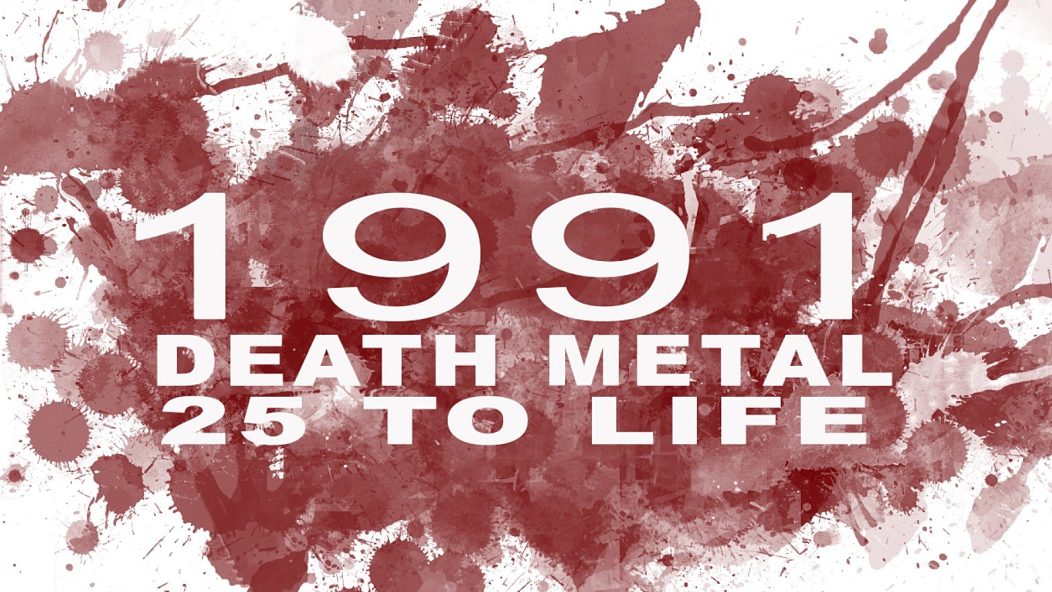
Death Metal 25 to Life: January - May 1991

…
Every great genre has a breakout year, a year when the sound progresses past its gestation and initial growing pains to a full-on cultural movement. Jazz had it in 1959, thrash in ’86, hip-hop in ’93. The musical foundations and lyrical tropes of death metal had been codified around the time Chuck Schuldiner, Rick Rozz and Kam Lee started banging out primal riff structures in suburban Orlando in the mid-‘80s. Mantas became Death, Scream Bloody Gore dropped in ’87 and there it was, in all of its gore-obsessed, primitive glory: death metal, a genre named for exactly what it sought to emulate. Others would add to its rickety skeleton over the next few years; Morbid Angel first fleshing out its compositions with classical-inspired musicianship and alien guitar leads on ’89’s Altars of Madness, then Entombed bulking up the sinew beneath with d-beats and leaden HM-2 tone the next year on Left Hand Path.
By ’91, death metal had grown physically, mentally and even spiritually, progressing from a small local scene in Florida with outposts in the Bay Area and Europe to a worldwide force stretching in all directions. This was the year death metal became ‘A Thing’, where all of its varying disciplines, splintering personalities and eclectic influences became manifest. As such, this 12 month period is packed with a dizzying array of classics from all across the spectrum, from stoner doom burnouts to techy jazz to punk beatdown. And it all happened a quarter century ago. What follows is a list of the 25 landmark albums from this most important of years in death metal, organized in chronological order. This is not a best-of list or a countdown. No, this is a celebration of all things bloody and gory, downtuned and chugged, growled and grunted, loud and brutal, fast and slow. This is the heart of the Golden Age of death metal. This is 25 to Life. Welcome to the party of putridity.
–Greg Majewski
…

…
Darkthrone – Soulside Journey (January 13th)
Death metal’s best year got off to an utterly bizarre start. At least it seems bizarre in retrospect. It began with the debut record from Darkthrone, Soulside Journey. Darkthrone has taken a multitude of shapes in their 25 year-plus career: Black metal, crust punk and even true metal are among them, but the Norwegian band started their career playing Swedish death metal. One can hear the direct influence from their Peaceville labelmates Autopsy, who made their mark on many of the youngsters in Stockholm. Speedy tunes like “Chromlech,” “Sempiternal Sepulchrality” and “The Watchtower” trade the rotted sickness of Severed Survival for crystal clear tremolo strikes that hint at Darkthrone’s incoming musical output.
Tomas Skogsberg, the engineer behind many of Swedish death metal’s best records, places Fenriz’s (who then joking went by “Hank Amarillo”) drums front and center like many of his best works. But Amarillo’s old-school attitude was already apparent here; his snare is almost entirely uncompressed, popping out of the mix one minute and burying itself in skanks the next. Even Nocturno Culto’s vocals are drenched in reverb and delay, a dry run at the necro production style of their future records. Juxtaposed against Culto’s full-throated growls and muck-free guitar tone and Amarillo’s pristine and meaty drum sound, the black metal elements sound unconfident and misplaced. Soulside Journey is still a rather fun piece–the title track runs circles around many young bands today–but it wasn’t Darkthrone’s finest hour, nor an indicator of the inspired and confident output that ultimately 1991 brought us.
–Avinash Mittur
…
…

…
Bolt Thrower – War Master (February)
In 1991, death metal was seven years old (if you count Possessed’s 1984 Death Metal demo as the starting point, which I do). At that age, human babies are well past potty training, but death metal was still a toddler. It wasn’t quite certain what it would wind up being – that’s why these records are so exciting. Many of them are debut albums. The few sophomores and even fewer third records in this murderer’s row tend to differ significantly from their predecessors.
Bolt Thrower, though, innovated something different: death metal consistency. War Master isn’t a quantum leap forward from their debut In Battle There is No Law, and its less-grind-toned followup Realm of Chaos. Rather, it’s the same war machine with the bolts screwed on a little tighter, the drums a little more pronounced, the vocals a little more gravelly, the production a little more clean (but not too clean!). The intros and outros were out, the riffs a smidgen faster. Hell, the pit-starter on War Master, “Cenotaph”, sounds a lot like a reworked version of the pit-starter on the previous album, “World Eater”, trisyllabic stand alone callouts and all (Bolt Thrower would re-visit this intro on many songs including “Powder Burns” and “The Killchain”). Of course, “World Eater” has the better riff, but “Cenotaph” doesn’t dilly dally – it’s almost a minute shorter. And really, comparing these two albums, like comparing any two Bolt Thrower albums, is comparing head shots. In 1991, while their contemporaries were finding their voices, or reaching for new things, Bolt Thrower knew who they were, and in death metal that was revolutionary at the time.
–Joseph Schafer
…
…

…
Sepultura – Arise (April 2nd)
Hold on. Hold on. Put the keyboard down. Yes, Sepultura is, or was, a thrash band more than a death metal band. But, see above, in 1991 the line between what did and did not constitute death metal was permeable. Sepultura played with death metal at their roots, but their previous album, Beneath the Remains, was an instant thrash classic. Arise split the difference between the two, and married to it the songwriting lessons gleaned from Slayer and Metallica. They didn’t try to sound like those bands – Max Cavalera’s Portuguese-tinted grunting would never let them pass for a Bay Area skate band, and in any case Sepultura’s interests were even more dismal. Instead they did what every press release says every band does but no bands never do – they focused on the songs! Even if Arise were an EP containing only the first three songs, it would be essential metal listening. Everyone with two ears and a heart deserves a dose of “Desperate Cry”. But people forget how good Arise is front-to back. “Under Siege, (Regnum Irae)” comes in a little more than halfway but displays all the clenched-fist bombast in its main riff that has come to embody Max-era Sepultura. Death? Thrash? Who cares? Decibel magazine called it the best metal album of 1991 and they weren’t wrong.
–Joseph Schafer
…
…

…
Asphyx – The Rack (April 13th)
What is the classic Asphyx lineup? Tough to tell. In 1991, the band, then a three-piece, had already been through multiple lineup changes, though not nearly as many as the group would withstand later. My guess is that most people would call the 1991 iteration of the group that recorded their debut The Rack definitive, even though only vocalist Martin Van Drunen remains from that lineup, and he was the new hire in 1991. Van Drunen had already cut his teeth in Pestilence by then, and his precise rasp gave Asphyx an edge not present on their handful of earlier demos. The point is, Asphyx was still very much an unknown quantity when they were making The Rack, which makes its remarkable strengths all the more noteworthy.
The smartest thing Asphyx did was slow down. After the requisite instrumental opener, the band launch into a punishing buzzsaw thrasher, “Vermin.” It’s great, but it’s also pretty predictable even by 1991 standards. And then, the band starts to crank the tempo down. “Diabolical Existence” works a creepy mid paced groove that the band revisits over and over on The Rack. Much of today’s death-doom owes as much to The Rack as anything from Paradise Lost or Anathema, maybe moreso since Asphyx plumbed the depths without any gothic overtures. Modern sadsack pounders also owe The Rack another listen; slow and atmospheric death metal is well and good, but there’s so much nuance to the damn thing, from the Iron Maiden-turned-sour leads on “Evocation” to the multifaceted and progressive journey of the dirgelike nine-minute title track. Asphyx themselves are still trying to replicate that piece de resistance.
–Joseph Schafer
…
…

…
Autopsy – Mental Funeral (April 22nd)
Until Asphyx and Autopsy came around, death metal was simply a logical progression from thrash. Faster polka-beats, gruffer vocals, lower-tuned guitar and decreasingly audible bass were the hallmarks of death metal’s evolution. Though Autopsy began their career in that vein with the frantic Severed Survival, their follow-up showcased something far grimier. Mental Funeral not only hinted at the groovier sounds that death metal was capable of, it slowed the genre down to a horrific, downright sinister crawl. The bluesy descending licks that kick off “In the Grip of Winter” quickly step aside for the slowest and meanest break heard in the genre at the time.
Drummer Chris Reifert’s vocals, drenched in reverb and entirely unintelligible, reek of sickness and decay, a genuinely scary sound. Most great death growls sound “cool.” Reifert’s sound fucked up. His dragging beats were the ideal complement to Eric Cutler and Danny Coralles’ guitars, who brought a fully stocked toolbox to the table on Mental Funeral. “Slaughterday” is the perfect showcase for the two. The track features murky swamp-thing chords, technical minor-scale licks, a triplet hellfire blitzkrieg and a tapping solo, because why not? That attitude is the only one that could have informed the creation of Mental Funeral, a death metal record that completely refused to follow the genre’s evolutionary trend.
–Avinash Mittur
…
…

…
Malevolent Creation – The Ten Commandments (April 24th)
The Ten Commandments does not begin auspiciously. Two and a half minutes of big, dumb power chords and a spoken word intro is not the way to introduce yourself to the music world. Malevolent Creation reward patience though; the high-gear riff-bonanza that opens “Premature Burial” is an instant body-mover. Drummer Mark Simpson was Malevolent Creation’s secret weapon on The Ten Commandments. Simpson’s relentless limbs glues the best elements of this record together; his hands and feet are what make the bumblebee riffs in “Remnants of Withered Decay” and “Thou Shall Kill!” pop and sound faster than they really are.
Vocalist Brett Hoffman and John Tardy of Obituary represent two sides of the Floridian death metal vocalist coin. When Tardy was at his best, he synthesized a nightmare from the bog. Hoffman erred on a thrashier side, evoking a more deranged Tom Araya. His crazed shouts kept the Phil Fasciana’s manic riffs in check–while his hands whizzed about the neck, Hoffman’s vocals kept Malevolent Creation’s tunes grounded on Earth. His opening scream to the band’s titular song kicks off a track that is absolute Kreator worship. This isn’t a bad thing; Malevolent Creation pay tribute to Pleasure to Kill better than just about any of their other Floridian counterparts. It makes for an album that delighted in its boundless energy and galloping bounce, nothing more and nothing less.
–Avinash Mittur
…
…

…
Unleashed – Where No Life Dwells (May 1st)
Interpersonal strife can lead to fruitful endeavors. Such was the case when Johnny Hedlund and seminal Swedish band Nihilist parted ways in 1989 (see also: Martin Van Drunen on Asphyx’s The Rack above). The rest of Nihilist went on to become Entombed (more on them later), and what did Hedlund do? Did he pout over being unanimously ousted from a band at the brink of brilliance? No, he took his battleaxe and formed his own damn horde. Unleashed is the hulking warrior to Entombed’s stripped down d-beat cage fighter, and Where No Life Dwells is its battle cry. First track proper “Dead Forever” burns through the gates with an instantly recognizable riff, white-hot blast beats and a breakdown meant to snap bones and bloody faces. And while Entombed packed similar attributes, Unleashed had and still have what their doppelgängers/arch rivals lost: that voice. Hedlund not only took his giant-ass bass with him, but he took a voice that matched. Gravelly, monstrously deep, at times grotesquely phlegmy, Hedlund’s is a growl made for death metal, a brutish register to match the Norsemen battle themes. Viking death metal starts here, and it starts with a hearty “Oooooogh!”
–Greg Majewski
…
…
This article has been amended to more correctly reflect the Bolt Thrower discography.
Old School Death Metal Week continues: Part 2, Part 3, Part 4










